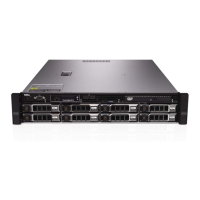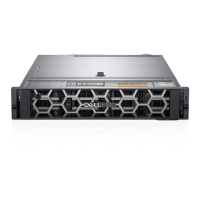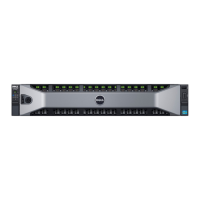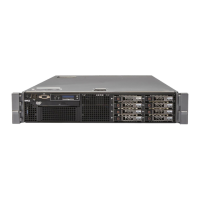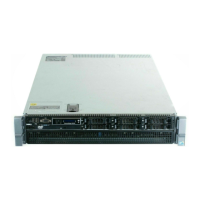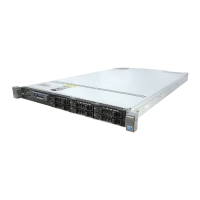




Do you have a question about the Dell PowerEdge R510 and is the answer not in the manual?
Lists keystrokes to access system features during startup.
Describes front panel buttons, indicators, and ports.
Explains the function and display of the optional LCD panel.
Details the four diagnostic indicator lights on the system front panel.
Provides information on system status and error messages displayed on the LCD.
Explains BIOS and UEFI boot modes and their selection for OS installation.
Details how to enter System Setup and use navigation keys for configuration.
Lists main setup screens like System Time, Memory, Processor, and Security settings.
Covers system and setup password configuration, assignment, and security.
Provides recommended tools and an overview of internal system components.
Guides for installing and removing hard drives and optical drives.
Instructions for installing and removing power supply modules.
Guidelines for installing, removing, and configuring system memory modules.
Covers installing and removing PCIe expansion cards and risers.
Instructions for installing and removing system processors.
Covers safety precautions and troubleshooting startup failures.
Guides for troubleshooting video, USB, serial, NIC, and wet systems.
Addresses problems with damaged systems, batteries, power, cooling, and memory.
Troubleshooting steps for USB keys, optical drives, hard drives, controllers, cards, and processors.
Explains how to use online and embedded system diagnostics.
Lists keystrokes to access system features during startup.
Describes front panel buttons, indicators, and ports.
Explains the function and display of the optional LCD panel.
Details the four diagnostic indicator lights on the system front panel.
Provides information on system status and error messages displayed on the LCD.
Explains BIOS and UEFI boot modes and their selection for OS installation.
Details how to enter System Setup and use navigation keys for configuration.
Lists main setup screens like System Time, Memory, Processor, and Security settings.
Covers system and setup password configuration, assignment, and security.
Provides recommended tools and an overview of internal system components.
Guides for installing and removing hard drives and optical drives.
Instructions for installing and removing power supply modules.
Guidelines for installing, removing, and configuring system memory modules.
Covers installing and removing PCIe expansion cards and risers.
Instructions for installing and removing system processors.
Covers safety precautions and troubleshooting startup failures.
Guides for troubleshooting video, USB, serial, NIC, and wet systems.
Addresses problems with damaged systems, batteries, power, cooling, and memory.
Troubleshooting steps for USB keys, optical drives, hard drives, controllers, cards, and processors.
Explains how to use online and embedded system diagnostics.
| HDD size | 3.5 \ |
|---|---|
| Hot-swap | Yes |
| HDD capacity | 450 GB |
| HDD interface | Serial Attached SCSI (SAS) |
| Total storage capacity | 900 GB |
| Number of HDDs installed | 2 |
| Number of HDDs supported | 8 |
| Internal memory | 4 GB |
| Memory clock speed | 1066 MHz |
| Internal memory type | DDR3-SDRAM |
| Maximum internal memory | 64 GB |
| Tcase | 76 °C |
| Bus type | QPI |
| Stepping | D0 |
| FSB Parity | No |
| Processor code | SLBF6 |
| Processor cache | 8 MB |
| Processor cores | 4 |
| Processor model | E5540 |
| System bus rate | 5.86 GT/s |
| Processor series | Intel Xeon 5500 Series |
| Processor socket | Socket B (LGA 1366) |
| Processor codename | Nehalem EP |
| Motherboard chipset | Intel® 5500 |
| Processing Die size | 263 mm² |
| Processor frequency | 2.53 GHz |
| Processor cache type | Smart Cache |
| Processor lithography | 45 nm |
| Processor system type | DP |
| Processor manufacturer | Intel |
| Processor package size | 42.5 x 45 mm |
| Processor front side bus | - MHz |
| Processor boost frequency | 2.8 GHz |
| Processor operating modes | 64-bit |
| Thermal Design Power (TDP) | 80 W |
| CPU multiplier (bus/core ratio) | 19 |
| Number of Processing Die Transistors | 731 M |
| Memory channels supported by processor | Triple |
| Memory clock speeds supported by processor | 800, 1066 MHz |
| Memory bandwidth supported by processor (max) | 25.6 GB/s |
| Maximum internal memory supported by processor | 144 GB |
| PS/2 ports quantity | 0 |
| Serial ports quantity | 1 |
| USB 2.0 ports quantity | 6 |
| Display | LCD |
| L1 cache | 0.064 MB |
| Form factor | - |
| Graphics card | G200eW |
| Dimensions (WxDxH) | 86.4 x 436.6 x 609.6 mm |
| Compatible operating systems | Microsoft Windows Small Business Server 2008/2003/ Novell SUSE Linux Enterprise Server 11/10 SP2 Linux Red Hat Enterprise 5.3/4.7 VMware vSphere Version 4.0 VMware ESX v3.5 / ESXi v3.5 |
| Power consumption (typical) | 1100 W |
| Noise level | 42 dB |
| Chassis type | Rack (2U) |
| PCI Express x4 slots | 3 |
| Processor ARK ID | 37104 |
| Intel® Turbo Boost Technology | 1.0 |
| Weight | 13500 g |
|---|
